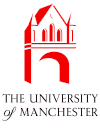
|
Manchester Applied Mathematics and Numerical Analysis SeminarsWinter 1999/2000 |

|
|---|

|
Manchester Applied Mathematics and Numerical Analysis SeminarsWinter 1999/2000 |

|
|---|
Simon Hubbard
Biomolecular Sciences, UMIST
Proteomics is an expanding field in bioscience research. By combining protein
chemistry, genomics, mass spectrometry and bioinformatics, we are
now able to identify proteins based from characteristic peptide mass
patterns. This has applications in the study of many important
biological processes such as disease, gene function, cell cycle and
cell development.
The informatics problems underlying proteomics will be discussed,
along with some of the current solutions and ideas for future
models and approaches.
[Top]
Robin Allaby
Biomolecular Sciences, UMIST
Domestication of wheat occurred 10,000 years ago in the Near East,
although it is unclear whether this was a single event or which part
of the Fertile Crescent was involved. Resolving this dispute using
molecular phylogeny presents a great challenge - wheat is a
genetically complex polyploid system and 10 000 years is an extremely
short period of time in terms of evolution. We have used two
approaches. The first examines a nuclear multigene family using
cladistic tree building analysis to compare alleles. Common ancestors
of alleles can be dated using genetic distance, and the biogeography
of antiquated alleles can be mapped. The resulting picture is
illuminating but limited in terms of resolution. The second approach
uses a gene system that evolves rapidly but violates Hennig's
cladistic assumptions and requires a novel approach to molecular
phylogeny. In this case a network approach is taken which allows for
multiple ancestry though recombination. The concept of genetic
distance has to be abandoned and a concept of genetic similarity
through recombination events is adopted. The emerging results from
using this are exciting and informative, and show that we have a
system that is biologically appropriate in its assumptions. However,
network construction limits the size of the usable data set and
represents an example of a system ripe for mathematical formalisation.
[Top]
Chris
Taylor and
Paul
Higgs
Bioinformatics, University of Manchester
Our work concerns neutral change in genotype under stabilising selection
on phenotype, the behaviour of quantitative traits, the rates at which
species evolve, and some of the processes which drive populations to
diverge and speciate.
Reductionist models constitute a powerful tool with which to understand, piece by piece, complex systems such as are found in the natural world. With the advent of faster computers, models become tractable which previously were not. While still only using a small subset of the features of the natural world, these models can provide a satisfying and useful approximation to it.
The MQT model represents organisms with Multiple Quantitative Traits,
where fitness is a function of phenotype only. The model incorporates
variable degrees of pleiotropy and epistasis for fitness. This
presentation will deal with the properties of the fitness landscapes
generated by the model, and some biological phenomena exhibited such as
neutral drift in genotype space, and differential adaptation.
[Top]
M.
Muldoon
Depts. of
Mathematics
and
Optometry & Neuroscience, UMIST
One normally expects talks about DNA and evolution to involve deep
time: a phylogenetic history of, say, whales, would span many millions
of years and might draw evidence from the fossil record. By contrast,
HIV evolves incredibly rapidly, with substantial genetic change
occuring over the course of a single individual's illness. In this
talk I will discuss a project that uses sequence data to estimate
the date of the emergence of modern clades of the virus. The main
technical innovation will be a generalisation of a model (originally
due to Jeff Thorne and his collaborators) that permits one to estimate
the ages of ancestral forms without having to assume a strict molecular
clock.
[Top]